使用神经网络识别手写数字Using neural nets to recognize handwritten digits
2016-03-20 12:53 GarfieldEr007 阅读(601) 评论(0) 编辑 收藏 举报The human visual system is one of the wonders of the world. Consider the following sequence of handwritten digits:

Most people effortlessly recognize those digits as 504192. That ease is deceptive. In each hemisphere of our brain, humans have a primary visual cortex, also known as V1, containing 140 million neurons, with tens of billions of connections between them. And yet human vision involves not just V1, but an entire series of visual cortices - V2, V3, V4, and V5 - doing progressively more complex image processing. We carry in our heads a supercomputer, tuned by evolution over hundreds of millions of years, and superbly adapted to understand the visual world. Recognizing handwritten digits isn't easy. Rather, we humans are stupendously, astoundingly good at making sense of what our eyes show us. But nearly all that work is done unconsciously. And so we don't usually appreciate how tough a problem our visual systems solve.
The difficulty of visual pattern recognition becomes apparent if you attempt to write a computer program to recognize digits like those above. What seems easy when we do it ourselves suddenly becomes extremely difficult. Simple intuitions about how we recognize shapes - "a 9 has a loop at the top, and a vertical stroke in the bottom right" - turn out to be not so simple to express algorithmically. When you try to make such rules precise, you quickly get lost in a morass of exceptions and caveats and special cases. It seems hopeless.
Neural networks approach the problem in a different way. The idea is to take a large number of handwritten digits, known as training examples,
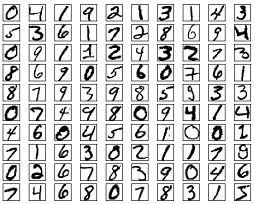
and then develop a system which can learn from those training examples. In other words, the neural network uses the examples to automatically infer rules for recognizing handwritten digits. Furthermore, by increasing the number of training examples, the network can learn more about handwriting, and so improve its accuracy. So while I've shown just 100 training digits above, perhaps we could build a better handwriting recognizer by using thousands or even millions or billions of training examples.
In this chapter we'll write a computer program implementing a neural network that learns to recognize handwritten digits. The program is just 74 lines long, and uses no special neural network libraries. But this short program can recognize digits with an accuracy over 96 percent, without human intervention. Furthermore, in later chapters we'll develop ideas which can improve accuracy to over 99 percent. In fact, the best commercial neural networks are now so good that they are used by banks to process cheques, and by post offices to recognize addresses.
We're focusing on handwriting recognition because it's an excellent prototype problem for learning about neural networks in general. As a prototype it hits a sweet spot: it's challenging - it's no small feat to recognize handwritten digits - but it's not so difficult as to require an extremely complicated solution, or tremendous computational power. Furthermore, it's a great way to develop more advanced techniques, such as deep learning. And so throughout the book we'll return repeatedly to the problem of handwriting recognition. Later in the book, we'll discuss how these ideas may be applied to other problems in computer vision, and also in speech, natural language processing, and other domains.
Of course, if the point of the chapter was only to write a computer program to recognize handwritten digits, then the chapter would be much shorter! But along the way we'll develop many key ideas about neural networks, including two important types of artificial neuron (the perceptron and the sigmoid neuron), and the standard learning algorithm for neural networks, known as stochastic gradient descent. Throughout, I focus on explaining why things are done the way they are, and on building your neural networks intuition. That requires a lengthier discussion than if I just presented the basic mechanics of what's going on, but it's worth it for the deeper understanding you'll attain. Amongst the payoffs, by the end of the chapter we'll be in position to understand what deep learning is, and why it matters.
Perceptrons
What is a neural network? To get started, I'll explain a type of artificial neuron called a perceptron. Perceptrons were developed in the 1950s and 1960s by the scientist Frank Rosenblatt, inspired by earlier work by Warren McCulloch and Walter Pitts. Today, it's more common to use other models of artificial neurons - in this book, and in much modern work on neural networks, the main neuron model used is one called the sigmoid neuron. We'll get to sigmoid neurons shortly. But to understand why sigmoid neurons are defined the way they are, it's worth taking the time to first understand perceptrons.
So how do perceptrons work? A perceptron takes several binary inputs, x1,x2,…x1,x2,…, and produces a single binary output:
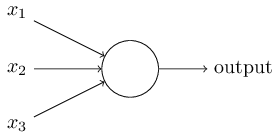
In the example shown the perceptron has three inputs, x1,x2,x3x1,x2,x3. In general it could have more or fewer inputs. Rosenblatt proposed a simple rule to compute the output. He introduced weights, w1,w2,…w1,w2,…, real numbers expressing the importance of the respective inputs to the output. The neuron's output, 00 or 11, is determined by whether the weighted sum ∑jwjxj∑jwjxj is less than or greater than some threshold value. Just like the weights, the threshold is a real number which is a parameter of the neuron. To put it in more precise algebraic terms:
That's all there is to how a perceptron works!
That's the basic mathematical model. A way you can think about the perceptron is that it's a device that makes decisions by weighing up evidence. Let me give an example. It's not a very realistic example, but it's easy to understand, and we'll soon get to more realistic examples. Suppose the weekend is coming up, and you've heard that there's going to be a cheese festival in your city. You like cheese, and are trying to decide whether or not to go to the festival. You might make your decision by weighing up three factors:
- Is the weather good?
- Does your boyfriend or girlfriend want to accompany you?
- Is the festival near public transit? (You don't own a car).
We can represent these three factors by corresponding binary variables x1,x2x1,x2, and x3x3. For instance, we'd have x1=1x1=1 if the weather is good, and x1=0x1=0 if the weather is bad. Similarly, x2=1x2=1if your boyfriend or girlfriend wants to go, and x2=0x2=0 if not. And similarly again for x3x3 and public transit.
Now, suppose you absolutely adore cheese, so much so that you're happy to go to the festival even if your boyfriend or girlfriend is uninterested and the festival is hard to get to. But perhaps you really loathe bad weather, and there's no way you'd go to the festival if the weather is bad. You can use perceptrons to model this kind of decision-making. One way to do this is to choose a weight w1=6w1=6for the weather, and w2=2w2=2 and w3=2w3=2 for the other conditions. The larger value of w1w1 indicates that the weather matters a lot to you, much more than whether your boyfriend or girlfriend joins you, or the nearness of public transit. Finally, suppose you choose a threshold of 55 for the perceptron. With these choices, the perceptron implements the desired decision-making model, outputting 11 whenever the weather is good, and 00 whenever the weather is bad. It makes no difference to the output whether your boyfriend or girlfriend wants to go, or whether public transit is nearby.
By varying the weights and the threshold, we can get different models of decision-making. For example, suppose we instead chose a threshold of 33. Then the perceptron would decide that you should go to the festival whenever the weather was good or when both the festival was near public transit and your boyfriend or girlfriend was willing to join you. In other words, it'd be a different model of decision-making. Dropping the threshold means you're more willing to go to the festival.
Obviously, the perceptron isn't a complete model of human decision-making! But what the example illustrates is how a perceptron can weigh up different kinds of evidence in order to make decisions. And it should seem plausible that a complex network of perceptrons could make quite subtle decisions:

In this network, the first column of perceptrons - what we'll call the first layer of perceptrons - is making three very simple decisions, by weighing the input evidence. What about the perceptrons in the second layer? Each of those perceptrons is making a decision by weighing up the results from the first layer of decision-making. In this way a perceptron in the second layer can make a decision at a more complex and more abstract level than perceptrons in the first layer. And even more complex decisions can be made by the perceptron in the third layer. In this way, a many-layer network of perceptrons can engage in sophisticated decision making.
Incidentally, when I defined perceptrons I said that a perceptron has just a single output. In the network above the perceptrons look like they have multiple outputs. In fact, they're still single output. The multiple output arrows are merely a useful way of indicating that the output from a perceptron is being used as the input to several other perceptrons. It's less unwieldy than drawing a single output line which then splits.
Let's simplify the way we describe perceptrons. The condition ∑jwjxj>threshold∑jwjxj>threshold is cumbersome, and we can make two notational changes to simplify it. The first change is to write ∑jwjxj∑jwjxj as a dot product, w⋅x≡∑jwjxjw⋅x≡∑jwjxj, where ww and xx are vectors whose components are the weights and inputs, respectively. The second change is to move the threshold to the other side of the inequality, and to replace it by what's known as the perceptron'sbias, b≡−thresholdb≡−threshold. Using the bias instead of the threshold, the perceptron rule can be rewritten:
You can think of the bias as a measure of how easy it is to get the perceptron to output a 11. Or to put it in more biological terms, the bias is a measure of how easy it is to get the perceptron to fire. For a perceptron with a really big bias, it's extremely easy for the perceptron to output a 11. But if the bias is very negative, then it's difficult for the perceptron to output a 11. Obviously, introducing the bias is only a small change in how we describe perceptrons, but we'll see later that it leads to further notational simplifications. Because of this, in the remainder of the book we won't use the threshold, we'll always use the bias.
I've described perceptrons as a method for weighing evidence to make decisions. Another way perceptrons can be used is to compute the elementary logical functions we usually think of as underlying computation, functions such as AND, OR, and NAND. For example, suppose we have a perceptron with two inputs, each with weight −2−2, and an overall bias of 33. Here's our perceptron:
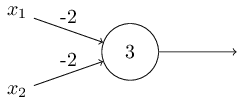
Then we see that input 0000 produces output 11, since (−2)∗0+(−2)∗0+3=3(−2)∗0+(−2)∗0+3=3 is positive. Here, I've introduced the ∗∗symbol to make the multiplications explicit. Similar calculations show that the inputs 0101 and 1010 produce output 11. But the input 1111produces output 00, since (−2)∗1+(−2)∗1+3=−1(−2)∗1+(−2)∗1+3=−1 is negative. And so our perceptron implements a NAND gate!
The NAND example shows that we can use perceptrons to compute simple logical functions. In fact, we can use networks of perceptrons to compute any logical function at all. The reason is that the NAND gate is universal for computation, that is, we can build any computation up out of NAND gates. For example, we can use NANDgates to build a circuit which adds two bits, x1x1 and x2x2. This requires computing the bitwise sum, x1⊕x2x1⊕x2, as well as a carry bit which is set to 11 when both x1x1 and x2x2 are 11, i.e., the carry bit is just the bitwise product x1x2x1x2:

To get an equivalent network of perceptrons we replace all the NANDgates by perceptrons with two inputs, each with weight −2−2, and an overall bias of 33. Here's the resulting network. Note that I've moved the perceptron corresponding to the bottom right NAND gate a little, just to make it easier to draw the arrows on the diagram:
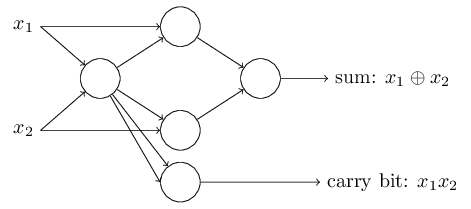
One notable aspect of this network of perceptrons is that the output from the leftmost perceptron is used twice as input to the bottommost perceptron. When I defined the perceptron model I didn't say whether this kind of double-output-to-the-same-place was allowed. Actually, it doesn't much matter. If we don't want to allow this kind of thing, then it's possible to simply merge the two lines, into a single connection with a weight of -4 instead of two connections with -2 weights. (If you don't find this obvious, you should stop and prove to yourself that this is equivalent.) With that change, the network looks as follows, with all unmarked weights equal to -2, all biases equal to 3, and a single weight of -4, as marked:
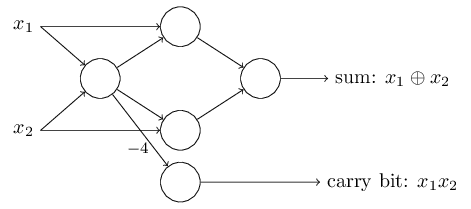
Up to now I've been drawing inputs like x1x1 and x2x2 as variables floating to the left of the network of perceptrons. In fact, it's conventional to draw an extra layer of perceptrons - the input layer- to encode the inputs:
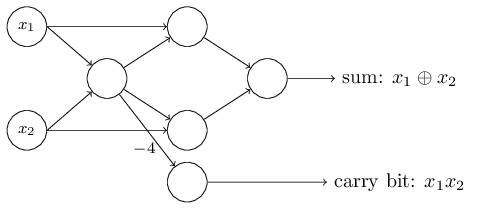
This notation for input perceptrons, in which we have an output, but no inputs,

is a shorthand. It doesn't actually mean a perceptron with no inputs. To see this, suppose we did have a perceptron with no inputs. Then the weighted sum ∑jwjxj∑jwjxj would always be zero, and so the perceptron would output 11 if b>0b>0, and 00 if b≤0b≤0. That is, the perceptron would simply output a fixed value, not the desired value (x1x1, in the example above). It's better to think of the input perceptrons as not really being perceptrons at all, but rather special units which are simply defined to output the desired values, x1,x2,…x1,x2,….
The adder example demonstrates how a network of perceptrons can be used to simulate a circuit containing many NAND gates. And because NAND gates are universal for computation, it follows that perceptrons are also universal for computation.
The computational universality of perceptrons is simultaneously reassuring and disappointing. It's reassuring because it tells us that networks of perceptrons can be as powerful as any other computing device. But it's also disappointing, because it makes it seem as though perceptrons are merely a new type of NAND gate. That's hardly big news!
However, the situation is better than this view suggests. It turns out that we can devise learning algorithms which can automatically tune the weights and biases of a network of artificial neurons. This tuning happens in response to external stimuli, without direct intervention by a programmer. These learning algorithms enable us to use artificial neurons in a way which is radically different to conventional logic gates. Instead of explicitly laying out a circuit ofNAND and other gates, our neural networks can simply learn to solve problems, sometimes problems where it would be extremely difficult to directly design a conventional circuit.
Sigmoid neurons
Learning algorithms sound terrific. But how can we devise such algorithms for a neural network? Suppose we have a network of perceptrons that we'd like to use to learn to solve some problem. For example, the inputs to the network might be the raw pixel data from a scanned, handwritten image of a digit. And we'd like the network to learn weights and biases so that the output from the network correctly classifies the digit. To see how learning might work, suppose we make a small change in some weight (or bias) in the network. What we'd like is for this small change in weight to cause only a small corresponding change in the output from the network. As we'll see in a moment, this property will make learning possible. Schematically, here's what we want (obviously this network is too simple to do handwriting recognition!):

If it were true that a small change in a weight (or bias) causes only a small change in output, then we could use this fact to modify the weights and biases to get our network to behave more in the manner we want. For example, suppose the network was mistakenly classifying an image as an "8" when it should be a "9". We could figure out how to make a small change in the weights and biases so the network gets a little closer to classifying the image as a "9". And then we'd repeat this, changing the weights and biases over and over to produce better and better output. The network would be learning.
The problem is that this isn't what happens when our network contains perceptrons. In fact, a small change in the weights or bias of any single perceptron in the network can sometimes cause the output of that perceptron to completely flip, say from 00 to 11. That flip may then cause the behaviour of the rest of the network to completely change in some very complicated way. So while your "9" might now be classified correctly, the behaviour of the network on all the other images is likely to have completely changed in some hard-to-control way. That makes it difficult to see how to gradually modify the weights and biases so that the network gets closer to the desired behaviour. Perhaps there's some clever way of getting around this problem. But it's not immediately obvious how we can get a network of perceptrons to learn.
We can overcome this problem by introducing a new type of artificial neuron called a sigmoid neuron. Sigmoid neurons are similar to perceptrons, but modified so that small changes in their weights and bias cause only a small change in their output. That's the crucial fact which will allow a network of sigmoid neurons to learn.
Okay, let me describe the sigmoid neuron. We'll depict sigmoid neurons in the same way we depicted perceptrons:

Just like a perceptron, the sigmoid neuron has inputs, x1,x2,…x1,x2,…. But instead of being just 00 or 11, these inputs can also take on any values between 00 and 11. So, for instance, 0.638…0.638… is a valid input for a sigmoid neuron. Also just like a perceptron, the sigmoid neuron has weights for each input, w1,w2,…w1,w2,…, and an overall bias, bb. But the output is not 00 or 11. Instead, it's σ(w⋅x+b)σ(w⋅x+b), where σσ is called the sigmoid function**Incidentally, σσ is sometimes called the logistic function, and this new class of neurons calledlogistic neurons. It's useful to remember this terminology, since these terms are used by many people working with neural nets. However, we'll stick with the sigmoid terminology., and is defined by:
To put it all a little more explicitly, the output of a sigmoid neuron with inputs x1,x2,…x1,x2,…, weights w1,w2,…w1,w2,…, and bias bb is
At first sight, sigmoid neurons appear very different to perceptrons. The algebraic form of the sigmoid function may seem opaque and forbidding if you're not already familiar with it. In fact, there are many similarities between perceptrons and sigmoid neurons, and the algebraic form of the sigmoid function turns out to be more of a technical detail than a true barrier to understanding.
To understand the similarity to the perceptron model, suppose z≡w⋅x+bz≡w⋅x+b is a large positive number. Then e−z≈0e−z≈0 and so σ(z)≈1σ(z)≈1. In other words, when z=w⋅x+bz=w⋅x+b is large and positive, the output from the sigmoid neuron is approximately 11, just as it would have been for a perceptron. Suppose on the other hand that z=w⋅x+bz=w⋅x+b is very negative. Then e−z→∞e−z→∞, and σ(z)≈0σ(z)≈0. So when z=w⋅x+bz=w⋅x+b is very negative, the behaviour of a sigmoid neuron also closely approximates a perceptron. It's only when w⋅x+bw⋅x+b is of modest size that there's much deviation from the perceptron model.
What about the algebraic form of σσ? How can we understand that? In fact, the exact form of σσ isn't so important - what really matters is the shape of the function when plotted. Here's the shape:
This shape is a smoothed out version of a step function:
If σσ had in fact been a step function, then the sigmoid neuron wouldbe a perceptron, since the output would be 11 or 00 depending on whether w⋅x+bw⋅x+b was positive or negative**Actually, when w⋅x+b=0w⋅x+b=0 the perceptron outputs 00, while the step function outputs 11. So, strictly speaking, we'd need to modify the step function at that one point. But you get the idea.. By using the actual σσfunction we get, as already implied above, a smoothed out perceptron. Indeed, it's the smoothness of the σσ function that is the crucial fact, not its detailed form. The smoothness of σσ means that small changes ΔwjΔwj in the weights and ΔbΔb in the bias will produce a small change ΔoutputΔoutput in the output from the neuron. In fact, calculus tells us that ΔoutputΔoutput is well approximated by
where the sum is over all the weights, wjwj, and ∂output/∂wj∂output/∂wj and ∂output/∂b∂output/∂b denote partial derivatives of the outputoutput with respect to wjwj and bb, respectively. Don't panic if you're not comfortable with partial derivatives! While the expression above looks complicated, with all the partial derivatives, it's actually saying something very simple (and which is very good news): ΔoutputΔoutput is a linear functionof the changes ΔwjΔwj and ΔbΔb in the weights and bias. This linearity makes it easy to choose small changes in the weights and biases to achieve any desired small change in the output. So while sigmoid neurons have much of the same qualitative behaviour as perceptrons, they make it much easier to figure out how changing the weights and biases will change the output.
If it's the shape of σσ which really matters, and not its exact form, then why use the particular form used for σσ in Equation (3)? In fact, later in the book we will occasionally consider neurons where the output is f(w⋅x+b)f(w⋅x+b) for some other activation function f(⋅)f(⋅). The main thing that changes when we use a different activation function is that the particular values for the partial derivatives in Equation(5) change. It turns out that when we compute those partial derivatives later, using σσ will simplify the algebra, simply because exponentials have lovely properties when differentiated. In any case, σσ is commonly-used in work on neural nets, and is the activation function we'll use most often in this book.
How should we interpret the output from a sigmoid neuron? Obviously, one big difference between perceptrons and sigmoid neurons is that sigmoid neurons don't just output 00 or 11. They can have as output any real number between 00 and 11, so values such as 0.173…0.173… and 0.689…0.689… are legitimate outputs. This can be useful, for example, if we want to use the output value to represent the average intensity of the pixels in an image input to a neural network. But sometimes it can be a nuisance. Suppose we want the output from the network to indicate either "the input image is a 9" or "the input image is not a 9". Obviously, it'd be easiest to do this if the output was a 00 or a 11, as in a perceptron. But in practice we can set up a convention to deal with this, for example, by deciding to interpret any output of at least 0.50.5 as indicating a "9", and any output less than 0.50.5 as indicating "not a 9". I'll always explicitly state when we're using such a convention, so it shouldn't cause any confusion.
Exercises
- Sigmoid neurons simulating perceptrons, part I
Suppose we take all the weights and biases in a network of perceptrons, and multiply them by a positive constant, c>0c>0. Show that the behaviour of the network doesn't change. - Sigmoid neurons simulating perceptrons, part II
Suppose we have the same setup as the last problem - a network of perceptrons. Suppose also that the overall input to the network of perceptrons has been chosen. We won't need the actual input value, we just need the input to have been fixed. Suppose the weights and biases are such that w⋅x+b≠0w⋅x+b≠0 for the input xx to any particular perceptron in the network. Now replace all the perceptrons in the network by sigmoid neurons, and multiply the weights and biases by a positive constant c>0c>0. Show that in the limit as c→∞c→∞ the behaviour of this network of sigmoid neurons is exactly the same as the network of perceptrons. How can this fail when w⋅x+b=0w⋅x+b=0 for one of the perceptrons?
The architecture of neural networks
In the next section I'll introduce a neural network that can do a pretty good job classifying handwritten digits. In preparation for that, it helps to explain some terminology that lets us name different parts of a network. Suppose we have the network:
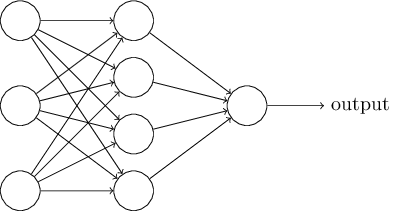
As mentioned earlier, the leftmost layer in this network is called the input layer, and the neurons within the layer are called input neurons. The rightmost or output layer contains the output neurons, or, as in this case, a single output neuron. The middle layer is called a hidden layer, since the neurons in this layer are neither inputs nor outputs. The term "hidden" perhaps sounds a little mysterious - the first time I heard the term I thought it must have some deep philosophical or mathematical significance - but it really means nothing more than "not an input or an output". The network above has just a single hidden layer, but some networks have multiple hidden layers. For example, the following four-layer network has two hidden layers:
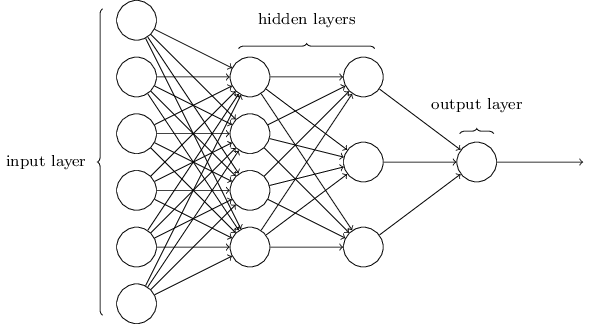
Somewhat confusingly, and for historical reasons, such multiple layer networks are sometimes called multilayer perceptrons orMLPs, despite being made up of sigmoid neurons, not perceptrons. I'm not going to use the MLP terminology in this book, since I think it's confusing, but wanted to warn you of its existence.
The design of the input and output layers in a network is often straightforward. For example, suppose we're trying to determine whether a handwritten image depicts a "9" or not. A natural way to design the network is to encode the intensities of the image pixels into the input neurons. If the image is a 6464 by 6464 greyscale image, then we'd have 4,096=64×644,096=64×64 input neurons, with the intensities scaled appropriately between 00 and 11. The output layer will contain just a single neuron, with output values of less than 0.50.5 indicating "input image is not a 9", and values greater than 0.50.5 indicating "input image is a 9 ".
While the design of the input and output layers of a neural network is often straightforward, there can be quite an art to the design of the hidden layers. In particular, it's not possible to sum up the design process for the hidden layers with a few simple rules of thumb. Instead, neural networks researchers have developed many design heuristics for the hidden layers, which help people get the behaviour they want out of their nets. For example, such heuristics can be used to help determine how to trade off the number of hidden layers against the time required to train the network. We'll meet several such design heuristics later in this book.
Up to now, we've been discussing neural networks where the output from one layer is used as input to the next layer. Such networks are called feedforward neural networks. This means there are no loops in the network - information is always fed forward, never fed back. If we did have loops, we'd end up with situations where the input to the σσ function depended on the output. That'd be hard to make sense of, and so we don't allow such loops.
However, there are other models of artificial neural networks in which feedback loops are possible. These models are calledrecurrent neural networks. The idea in these models is to have neurons which fire for some limited duration of time, before becoming quiescent. That firing can stimulate other neurons, which may fire a little while later, also for a limited duration. That causes still more neurons to fire, and so over time we get a cascade of neurons firing. Loops don't cause problems in such a model, since a neuron's output only affects its input at some later time, not instantaneously.
Recurrent neural nets have been less influential than feedforward networks, in part because the learning algorithms for recurrent nets are (at least to date) less powerful. But recurrent networks are still extremely interesting. They're much closer in spirit to how our brains work than feedforward networks. And it's possible that recurrent networks can solve important problems which can only be solved with great difficulty by feedforward networks. However, to limit our scope, in this book we're going to concentrate on the more widely-used feedforward networks.
A simple network to classify handwritten digits
Having defined neural networks, let's return to handwriting recognition. We can split the problem of recognizing handwritten digits into two sub-problems. First, we'd like a way of breaking an image containing many digits into a sequence of separate images, each containing a single digit. For example, we'd like to break the image

into six separate images,

We humans solve this segmentation problem with ease, but it's challenging for a computer program to correctly break up the image. Once the image has been segmented, the program then needs to classify each individual digit. So, for instance, we'd like our program to recognize that the first digit above,

is a 5.
We'll focus on writing a program to solve the second problem, that is, classifying individual digits. We do this because it turns out that the segmentation problem is not so difficult to solve, once you have a good way of classifying individual digits. There are many approaches to solving the segmentation problem. One approach is to trial many different ways of segmenting the image, using the individual digit classifier to score each trial segmentation. A trial segmentation gets a high score if the individual digit classifier is confident of its classification in all segments, and a low score if the classifier is having a lot of trouble in one or more segments. The idea is that if the classifier is having trouble somewhere, then it's probably having trouble because the segmentation has been chosen incorrectly. This idea and other variations can be used to solve the segmentation problem quite well. So instead of worrying about segmentation we'll concentrate on developing a neural network which can solve the more interesting and difficult problem, namely, recognizing individual handwritten digits.
To recognize individual digits we will use a three-layer neural network:
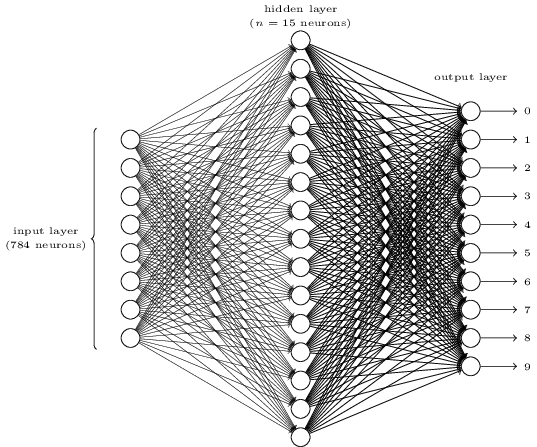
The input layer of the network contains neurons encoding the values of the input pixels. As discussed in the next section, our training data for the network will consist of many 2828 by 2828 pixel images of scanned handwritten digits, and so the input layer contains 784=28×28784=28×28 neurons. For simplicity I've omitted most of the 784784 input neurons in the diagram above. The input pixels are greyscale, with a value of 0.00.0 representing white, a value of 1.01.0representing black, and in between values representing gradually darkening shades of grey.
The second layer of the network is a hidden layer. We denote the number of neurons in this hidden layer by nn, and we'll experiment with different values for nn. The example shown illustrates a small hidden layer, containing just n=15n=15 neurons.
The output layer of the network contains 10 neurons. If the first neuron fires, i.e., has an output ≈1≈1, then that will indicate that the network thinks the digit is a 00. If the second neuron fires then that will indicate that the network thinks the digit is a 11. And so on. A little more precisely, we number the output neurons from 00 through99, and figure out which neuron has the highest activation value. If that neuron is, say, neuron number 66, then our network will guess that the input digit was a 66. And so on for the other output neurons.
You might wonder why we use 1010 output neurons. After all, the goal of the network is to tell us which digit (0,1,2,…,90,1,2,…,9) corresponds to the input image. A seemingly natural way of doing that is to use just44 output neurons, treating each neuron as taking on a binary value, depending on whether the neuron's output is closer to 00 or to 11. Four neurons are enough to encode the answer, since 24=1624=16 is more than the 10 possible values for the input digit. Why should our network use 1010 neurons instead? Isn't that inefficient? The ultimate justification is empirical: we can try out both network designs, and it turns out that, for this particular problem, the network with 1010output neurons learns to recognize digits better than the network with 44 output neurons. But that leaves us wondering why using 1010output neurons works better. Is there some heuristic that would tell us in advance that we should use the 1010-output encoding instead of the 44-output encoding?
To understand why we do this, it helps to think about what the neural network is doing from first principles. Consider first the case where we use 1010 output neurons. Let's concentrate on the first output neuron, the one that's trying to decide whether or not the digit is a 00. It does this by weighing up evidence from the hidden layer of neurons. What are those hidden neurons doing? Well, just suppose for the sake of argument that the first neuron in the hidden layer detects whether or not an image like the following is present:
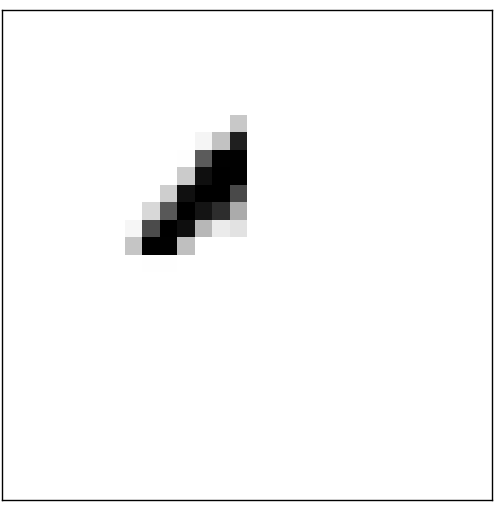
It can do this by heavily weighting input pixels which overlap with the image, and only lightly weighting the other inputs. In a similar way, let's suppose for the sake of argument that the second, third, and fourth neurons in the hidden layer detect whether or not the following images are present:

As you may have guessed, these four images together make up the 00image that we saw in the line of digits shown earlier:
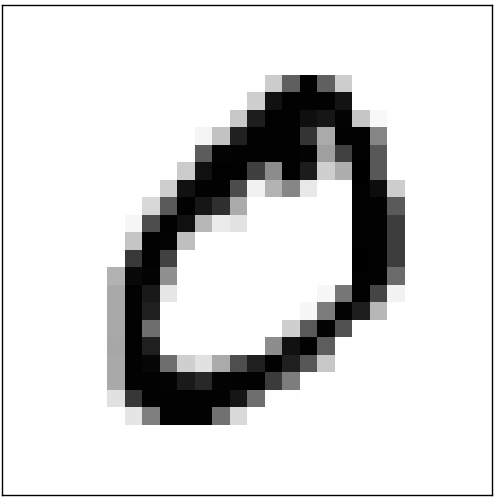
So if all four of these hidden neurons are firing then we can conclude that the digit is a 00. Of course, that's not the only sort of evidence we can use to conclude that the image was a 00 - we could legitimately get a 00 in many other ways (say, through translations of the above images, or slight distortions). But it seems safe to say that at least in this case we'd conclude that the input was a 00.
Supposing the neural network functions in this way, we can give a plausible explanation for why it's better to have 1010 outputs from the network, rather than 44. If we had 44 outputs, then the first output neuron would be trying to decide what the most significant bit of the digit was. And there's no easy way to relate that most significant bit to simple shapes like those shown above. It's hard to imagine that there's any good historical reason the component shapes of the digit will be closely related to (say) the most significant bit in the output.
Now, with all that said, this is all just a heuristic. Nothing says that the three-layer neural network has to operate in the way I described, with the hidden neurons detecting simple component shapes. Maybe a clever learning algorithm will find some assignment of weights that lets us use only 44 output neurons. But as a heuristic the way of thinking I've described works pretty well, and can save you a lot of time in designing good neural network architectures.
Exercise
- There is a way of determining the bitwise representation of a digit by adding an extra layer to the three-layer network above. The extra layer converts the output from the previous layer into a binary representation, as illustrated in the figure below. Find a set of weights and biases for the new output layer. Assume that the first 33 layers of neurons are such that the correct output in the third layer (i.e., the old output layer) has activation at least 0.990.99, and incorrect outputs have activation less than 0.010.01.
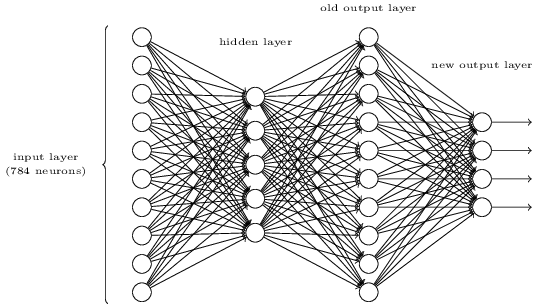
Learning with gradient descent
Now that we have a design for our neural network, how can it learn to recognize digits? The first thing we'll need is a data set to learn from - a so-called training data set. We'll use the MNIST data set, which contains tens of thousands of scanned images of handwritten digits, together with their correct classifications. MNIST's name comes from the fact that it is a modified subset of two data sets collected by NIST, the United States' National Institute of Standards and Technology. Here's a few images from MNIST:

As you can see, these digits are, in fact, the same as those shown at the beginning of this chapter as a challenge to recognize. Of course, when testing our network we'll ask it to recognize images which aren't in the training set!
The MNIST data comes in two parts. The first part contains 60,000 images to be used as training data. These images are scanned handwriting samples from 250 people, half of whom were US Census Bureau employees, and half of whom were high school students. The images are greyscale and 28 by 28 pixels in size. The second part of the MNIST data set is 10,000 images to be used as test data. Again, these are 28 by 28 greyscale images. We'll use the test data to evaluate how well our neural network has learned to recognize digits. To make this a good test of performance, the test data was taken from a different set of 250 people than the original training data (albeit still a group split between Census Bureau employees and high school students). This helps give us confidence that our system can recognize digits from people whose writing it didn't see during training.
We'll use the notation xx to denote a training input. It'll be convenient to regard each training input xx as a 28×28=78428×28=784-dimensional vector. Each entry in the vector represents the grey value for a single pixel in the image. We'll denote the corresponding desired output by y=y(x)y=y(x), where yy is a 1010-dimensional vector. For example, if a particular training image, xx, depicts a 66, then y(x)=(0,0,0,0,0,0,1,0,0,0)Ty(x)=(0,0,0,0,0,0,1,0,0,0)T is the desired output from the network. Note that TT here is the transpose operation, turning a row vector into an ordinary (column) vector.
What we'd like is an algorithm which lets us find weights and biases so that the output from the network approximates y(x)y(x) for all training inputs xx. To quantify how well we're achieving this goal we define a cost function**Sometimes referred to as a loss or objectivefunction. We use the term cost function throughout this book, but you should note the other terminology, since it's often used in research papers and other discussions of neural networks.:
Here, ww denotes the collection of all weights in the network, bb all the biases, nn is the total number of training inputs, aa is the vector of outputs from the network when xx is input, and the sum is over all training inputs, xx. Of course, the output aa depends on xx, ww and bb, but to keep the notation simple I haven't explicitly indicated this dependence. The notation ∥v∥∥v∥ just denotes the usual length function for a vector vv. We'll call CC the quadratic cost function; it's also sometimes known as the mean squared error or just MSE. Inspecting the form of the quadratic cost function, we see that C(w,b)C(w,b) is non-negative, since every term in the sum is non-negative. Furthermore, the cost C(w,b)C(w,b) becomes small, i.e., C(w,b)≈0C(w,b)≈0, precisely when y(x)y(x) is approximately equal to the output, aa, for all training inputs,

